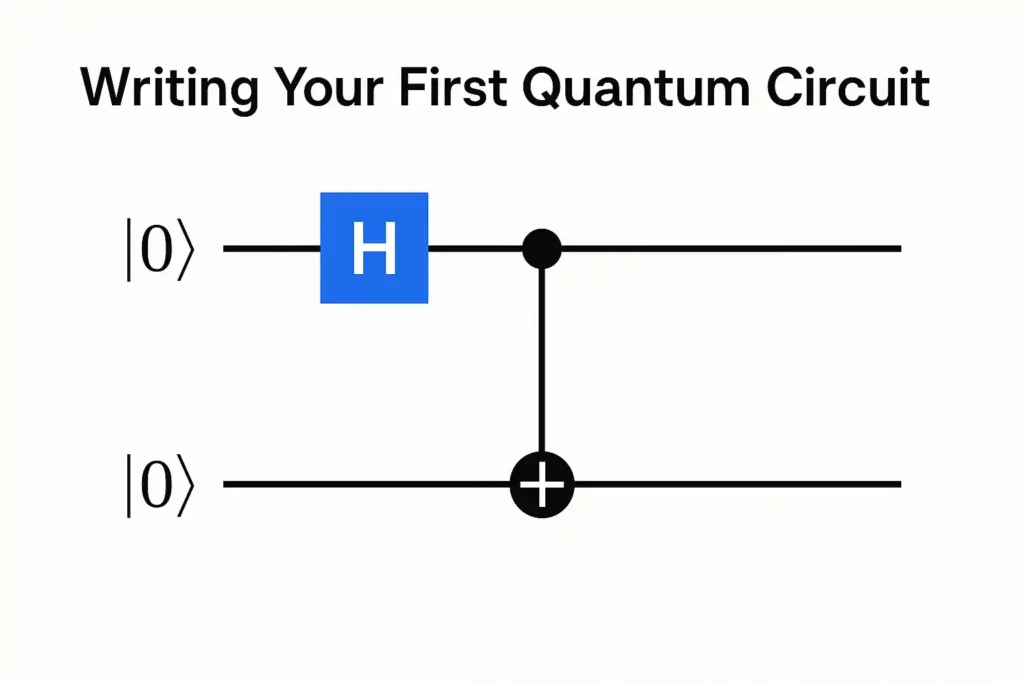Table of Contents
- Introduction
- What Is a Quantum Circuit?
- Prerequisites for Running a Circuit
- Installing and Importing Qiskit
- Building a Basic Quantum Circuit
- Commonly Used Quantum Gates
- Applying Quantum Gates Step-by-Step
- Visualizing the Circuit
- Adding Measurements to Qubits
- Choosing a Backend (Simulator vs Real Device)
- Executing the Circuit on a Simulator
- Viewing and Interpreting Results
- Running the Circuit on IBM Quantum Hardware
- Using Qiskit Tools for Circuit Analysis
- Saving and Reusing Circuits
- Tips for Beginners
- Common Errors and How to Fix Them
- Expanding to Multi-Qubit Circuits
- Sample Exercises
- Conclusion
1. Introduction
Creating your first quantum circuit is an exciting step toward understanding and using quantum computers. This guide uses Qiskit to walk you through building, visualizing, and running a simple quantum circuit.
2. What Is a Quantum Circuit?
A quantum circuit is a sequence of quantum gates applied to qubits. It’s the quantum analog of a classical logic circuit, but with reversible and probabilistic behavior.

3. Prerequisites for Running a Circuit
- Python 3.7 or later
- Qiskit installed (
pip install qiskit) - Optional: Jupyter Notebook for an interactive experience
4. Installing and Importing Qiskit
pip install qiskitIn Python:
from qiskit import QuantumCircuit, Aer, execute5. Building a Basic Quantum Circuit
qc = QuantumCircuit(2, 2) # 2 qubits, 2 classical bitsThis initializes a circuit with 2 qubits and 2 classical bits for measurement results.
6. Commonly Used Quantum Gates
- X: Pauli-X (NOT)
- H: Hadamard (superposition)
- CX: CNOT (entanglement)
- Z, Y, S, T: phase and rotation gates
7. Applying Quantum Gates Step-by-Step
qc.h(0) # Apply Hadamard gate to qubit 0
qc.cx(0, 1) # Apply CNOT with control=0, target=18. Visualizing the Circuit
print(qc.draw())Or in Jupyter:
qc.draw('mpl')9. Adding Measurements to Qubits
qc.measure([0, 1], [0, 1]) # Measure qubit 0 into bit 0, qubit 1 into bit 110. Choosing a Backend (Simulator vs Real Device)
Use the Aer simulator for fast testing:
simulator = Aer.get_backend('qasm_simulator')11. Executing the Circuit on a Simulator
job = execute(qc, simulator, shots=1024)
result = job.result()
counts = result.get_counts(qc)
print(counts)12. Viewing and Interpreting Results
from qiskit.visualization import plot_histogram
plot_histogram(counts)This shows the probability distribution over measured outcomes.
13. Running the Circuit on IBM Quantum Hardware
from qiskit_ibm_provider import IBMProvider
provider = IBMProvider()
backend = provider.get_backend('ibmq_qasm_simulator')
job = execute(qc, backend, shots=1024)14. Using Qiskit Tools for Circuit Analysis
from qiskit.transpiler import PassManager
from qiskit.transpiler.passes import Depth
pm = PassManager(Depth())
print(pm.run(qc))15. Saving and Reusing Circuits
qc.qasm(filename="my_first_circuit.qasm")Or save with Python pickle:
import pickle
with open("my_circuit.pkl", "wb") as f:
pickle.dump(qc, f)16. Tips for Beginners
- Start with 1-2 qubit circuits
- Use simulators before real devices
- Explore gates visually
- Experiment with different combinations
17. Common Errors and How to Fix Them
- Missing measurements → No classical result
- Backend not found → Check Aer or IBM setup
- API error → Verify IBM token and internet
18. Expanding to Multi-Qubit Circuits
Try:
qc = QuantumCircuit(3, 3)
qc.h(0)
qc.cx(0, 1)
qc.cx(1, 2)
qc.measure([0,1,2], [0,1,2])19. Sample Exercises
- Create a Bell state and verify entanglement
- Implement a Deutsch-Jozsa algorithm
- Simulate Grover’s algorithm with 2 qubits
20. Conclusion
Writing your first quantum circuit opens the door to a new computing paradigm. Using Qiskit, you can simulate, analyze, and eventually run your circuits on real quantum processors.

